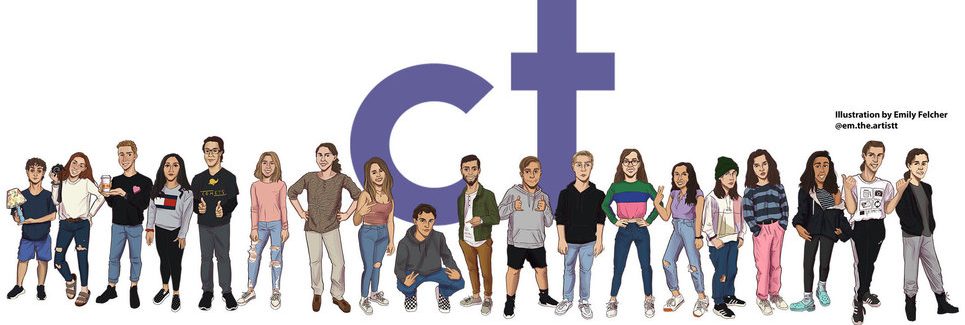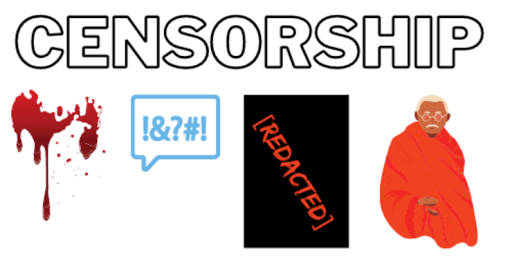Does Censorship Need to be Changed in Today’s Age?
Censorship could use some reforms.
December 11, 2020
The existence of censorship and content restrictions has always been a heated topic. According to Oxford Languages, “Censorship” is defined as “the suppression of speech, public communication, or other information on the basis that such material is considered ‘harmful.’” In the case of entertainment, this same definition applies to imagery and content in general. Some parties support censorship, pushing for more and more in order to maintain innocence among younger audiences, and some parties push for less censorship, as to not blind the younger audiences to some aspects of real life. That’s just a paraphrase, as there are varying viewpoints and reasons on both sides, but the fact remains that censorship is always changing. Whether it be the banning of books or bleeping out inappropriate language in songs on the radio, censorship in the media has always existed to some extent. These extents vary greatly, from banning the satirization of religious figures to restricting use of foul language, as well as more extreme cases, like giving an R rating to a gory or sexually explicit film. Concepts like these raise a question: How much censorship is enough, and how much is too much?
There are many forms of censorship or content warning, and one that has remained fluid and changing is the MPAA (Motion Picture Association of America) rating system. In short, G and PG rated films are appropriate for children, PG-13 rated films are appropriate for older children and teenagers, and an R rated film is appropriate for older teenagers and adults. It’s a fair rating system, but the content that judges a movie’s placement on the scale is where the problems lie.
According to the film submission guidelines of the MPAA, there are six major elements that go into rating a movie: Violence, sexual content, alcohol/drug use, explicit language, theme, and adult activity. One would think violence and sexual content would be more heavily judged than the others, but that’s not entirely the case. (PG-13 Rating). In the movie Cloverfield, which is rated PG-13, several people are killed in rather violent ways. However, since the usual blood is swapped out for alien goo, it passes the test. There is a also good amount of foul language, and the theme of the movie is pretty tense, but very little sexual content, alcohol/drug use, or adult activity is portrayed in the movie. However, in the movie The King’s Speech, which is rated R, there is no sexual or violent content, as well as minimal alcohol/drug use and adult activity. The theme is simply a well told history lesson, so why is it rated R? A PG-13 rated film is permitted one use of the f-word, and in one single scene, the movie features the main character in a speech therapy lesson where he uses swear words as a vocal exercise. He drops the f-bomb several times, as well as an arsenal of other foul remarks, earning the movie an R-rating, and limiting its marketability to younger audiences. PG-13 movies like Happy Death Day, which features a fine smattering of generally inappropriate content in all categories, receive lots of marketing opportunities, because PG-13 movies often draw in younger audiences, but an R-rated movie like Don’t Think Twice, which features one f-bomb and some marijuana use, miss out. If young viewers are discouraged by the rating, the movie can’t really advertise to them, and they miss out on a lucrative demographic almost entirely. A simple rating can either make or break a movie, and the skewed criteria for those ratings are causing a lot of movies to miss out on a lot of money.
Another somewhat restrictive form of censorship is a ban or limit on forms of satire. One of the debated interpretations of the phrase Freedom of Speech is the right to use satire and parody. Using historical and religious figures in comedy, while legal, can sometimes be considered offensive, and that was the case for Clone High’s depiction of Mahatma Gandhi. The influential statesman had been portrayed as an off the wall party-hard teen in the show, and many Indian citizens had an issue with this. The show was soon cancelled because of it, and poor teenage Gandhi never got to party again. An article published in 2003 by Animation Magazine stated that MTV “defends the series, saying it is intended for U.S. audiences who are accustomed to the satirizing of public figures.” An additional case of satire censorship came in South Park, a show notorious for its constant rude and crude jokes. In the episode Cartoon Wars Part I, a plot line surrounds the risks of airing an uncensored image of the Muslim prophet Muhammad, and while in the end, the image shown in the episode was censored, the jokes about it caused some backlash. When the plot line was re-imagined in the episode 200, it really caused an uproar. Death threats were aimed towards the creators of the show, causing a revision and harsh censorship of that episode, and the following episode, as well as a TV-MA rating. Admittedly, the South Park controversy was somewhat meant to cause a stir, but at the end of the day, it was only satire. Jokes like Clone High’s portrayal of Gandhi and South Park’s portrayal of Muhammad have a very small impact in the grand scheme of things, but the impact they do have has called for censorship, altering the final product, and prohibiting the public from seeing the full picture as it was intended.
This is the biggest problem with censorship: No matter how small or irrelevant, it’s still silencing a voice somewhere, and removing that one piece from the overall puzzle. It’s a large issue outside of entertainment as well, with incomplete textbooks, biased reports, and corrupt investigations. While in some real-world cases, censorship can be good, there is rarely a case in the entertainment industry where fundamentally changing a story just so that a movie can meet PG-13 standards, or removing debatably well-intended jokes from a show so that people are less offended, is beneficial. Revisions to the system of censorship should be examined, so that content isn’t unfairly altered, and artists can freely express their art.
Here is a censorship survey for GLHS students to answer whether or not they view R rated movies/play M rated video games.






